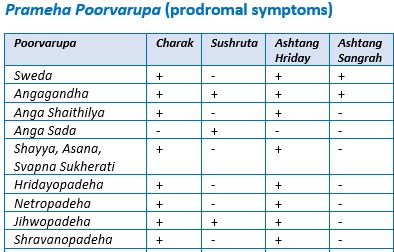Significance of Poorvarupa (Prodromal feature) of Prameha – A Review Article
Keywords:
Prameha, Poorvarupa, Nidan Panchaka, AyurvedaAbstract
Prameha as well as diabetes is an important public health menace due to its high morbidity, mortality, economic impact, resource consumption, systemic complications, silent yet progressive nature, and less curative options. The prevalence of diabetes is also higher in urban areas than rural areas. In India over all 2.4% rural population and 4.6 – 11.6% urban population is suffering from diabetes. Systematic diagnosis of disease is well explained under the heading of Nidan Panchaka (Fivefold of examination) Viz. Nidan (Etiological factors), Poorvarupa (Prodromal features), Rupa (Specific sign and symptoms), Upasaya (Relieving factors) and Samprapti (Pathogenesis). Among the Nidan Panchaka, Poorvarupa (Prodromal features) are the symptoms which indicate the forthcoming disease. The long-term effects include progressive development of retinopathy with potential blindness, nephropathy that may lead to renal failure, neuropathy with risk of foot ulcers, amputation, Charcot joints and features of autonomic dysfunction including sexual dysfunction. People with diabetes are at increased risk of cardiovascular, peripheral vascular and cerebrovascular disease.
Downloads
References
Murthy Shrikant K. R., Astanga Hrdayam Vagbhata’s, Varanasi, Chowkhamba Krishndas Academy Reprint: 2018 Nidan Sthan, Chapter 10, Verse 6.
Sastri Sri Sudarsana, Upadhyaya Yadunandana, Madhava Nidanam of sri Madhavakara, Varanasi, Chaukhamba Sanskrit Sansthan, part 2, Reprint: 2055, 27th edition, Chapter 33, verse 1.
Sastri Sri Sudarsana, Upadhyaya Yadunandana, Madhava Nidanam of sri Madhavakara, Varanasi, Chaukhamba Sanskrit Sansthan, part 2, Reprint:2055, 27th edition, Chapter 33, verse 5.
Tripathi Ravi Dutta, Shukla Vidyadhar, Charaka Samhita, Chawkhamba Sanskrit Pratishthan, Delhi, Reprint: 2009 Vol I Nidan Sthan, chapter 4, verse 47.
Tripathi Ravi Dutta, Shukla Vidyadhar, Charaka Samhita, Chawkhamba Sanskrit Pratishthan, Delhi, Reprint: 2009 Vol II, chapter 6, verse 12.
Longo Dan.l. et al editors, Principle of internal medicine Harrison’s, volume 2, ISBN 978-0-07-174887-2 Library of congress cataloging in publication Data, 18th edition 2012, chapter 344, Pp2968.
National family health survey (NFHS) – IV, 2015-16
https://www.frontiersin.org › fpubh.2022.748157
Pandey Gangasahay, Yadavii Takamaji, Sharma Priyavrit. Charaka Samhita of Charaka, Nidansthana, chapter 1, verse no 36, 1st edition Varanasi; Chaukhambha Sanskrit Sansthan, 2007:482-83.















